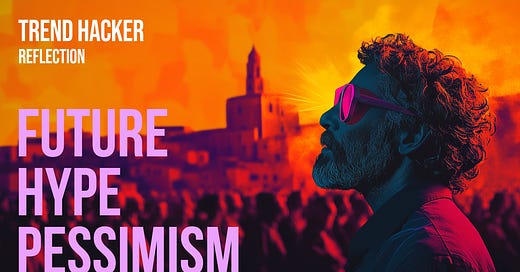Or can we have both? In the world of strategic foresight, futurism, or however you call it—I'm keeping the distinctions out of this discussion—there's a lot of inspiration, emotion, hype, academic research, deep scenario building, and policy-making.
However, on social media, the former generates more clicks. Flashing news generates curiosity; a new hype sparks hopes and fears, and a new tech lets us imagine the world as we did when we were young, reading and watching all those sci-fi books and movies, feeling like it's turning into reality.
But reality is, well, different. Just look at the latest election in your country; observe people in the supermarket or a public space, and we see that the world is often different than we think; more colorful.
The construction site in front of your condo never seems to end, the projector still has glitches connecting to the computer, and around 2.6 billion people worldwide seem to be unconnected—that's around 33% of the world's population in 2022.
When we see the latest Facebook Orion—an important billion-dollar step into a future direction—and currently costing around $10,000 to make (Business Insider), we might think that the world of tomorrow is already here. Finally.
Yet we forget that even if the price comes down quickly in the next few years, yet when the goal is to get close to today's global mobile phone penetration of 54% (GSMA’s annual State of Mobile Internet Connectivity Report 2023), it might not happen tomorrow.
The statement that AR glasses will take over the mobile phone might be true, but the question is when.
When will the next generation of solid-state batteries be available? When can 80% of the population spend a couple of hundred dollars on a new device? When will we have all the latency and processing power to create shared, common online spaces at a truly massive scale? When will we have all the regulatory frameworks in place that are aligned with local data privacy laws?
Besides, there are many "ifs" involved. There will also be counter-movements, some mobilizations that weaken or taunt the trend, not to speak about the need to adapt societal value patterns; some people will always work against it.
That could be due to social values or economic shifts that increase the gap between social classes, leaving many focused on survival rather than personal growth. Privacy concerns, digital fatigue, and the potential for increased social isolation are just a few human-centric challenges that could hinder widespread adoption.
That's when a great tech gets dragged down by questions—questions that we honestly don't want to hear because we were excited by the latest news, the hype, and the possibilities that we can realize if such a tech could exist tomorrow.
So we shall ask questions and doubt the hype, and many call those people pessimists. Even worse, the posts are lost in the realm of algorithmic prioritization.
However, risk management and prevention, or looking at a more holistic picture, is not about negativity. It is a more pragmatic, practical way of exploring possibilities in the future. It's about acknowledging that technological progress isn't always linear or universally beneficial. It's about understanding that the human element—our needs, fears, and aspirations—is inextricably linked to the success or failure of any new technology.
Tech, social, and legal frameworks take time to become mass-produced, acceptable, and integrated, especially when hardware is part of the new game. While we dream of a future where AR glasses seamlessly integrate into our lives, it's crucial to remember that the path to that future is paved with technological hurdles and the complexities of human experience.
So, back to our initial question: visionary or pragmatic? The answer is a resounding "both," where pragmatism is often needed but not...well, desired.
Yet this is precisely where true foresight lies. Daring to dream, painting those vivid pictures of tech wonders and how society will change… that's what sparks innovation and drives us forward. But to navigate tomorrow's unknown territory, we must also embrace our inner skeptic, who questions everything and pokes holes in the overly optimistic stories to bring it down to companies' reality and their strategy set.
It's the antidote to the blind optimism, hype, 7000ish-liked, and shared social media posts. It forces us to face our big ideas' potential downsides and unintended consequences. By embracing this inner pragmatist, we gain a more realistic understanding of the challenges ahead, allowing us to foresee and tackle risks head-on.
When we shift back to the hype, to that tempting vision of the future we might crave, we do it with a clearer head and not an online presentation on a PowerPoint about "tomorrow's life-changing trends." We see more of the fantastic potential alongside the potential risks.
Embrace the pragmatic possibilities.
👋🏻 Want a pragmatic and inspirational professional session to help bring your ideas to life? Send me a DM.





